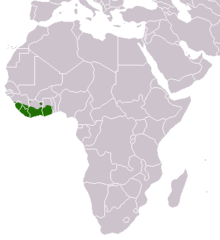Common kusimanse
| Common kusimanse | |
|---|---|
 |
|
| Scientific classification | |
| Kingdom: | Animalia |
| Phylum: | Chordata |
| Class: | Mammalia |
| Order: | Carnivora |
| Family: | Herpestidae |
| Genus: | Crossarchus |
| Species: | C. obscurus |
| Binomial name | |
|
Crossarchus obscurus G. Cuvier, 1825 |
|
 |
|
| Common kusimanse range | |
The common kusimanse (Crossarchus obscurus), also known as the long-nosed kusimanse or cusimanse, is a small, diurnal kusimanse or dwarf mongoose. Of three subfamilies of Herpestidae (Herpestinae, Mungotinae and Galidiinae), the kusimanse is a member of Mungotinae, which are small and very social.
The common kusimanse has a vaguely weasel-shaped body with dark or reddishbrown fur that is thick, with a wiry texture down the back, and fine and soft on the underside. It has a long snout, short legs, a short, relatively stiff tail which tapers to a point, long claws, small ears, small, dark colored eyes, and an elongated nose. Adult size is typically around 33 cm (13 in) with a weight of approximately 1 kg (2.2 lb).
This mongoose is a highly social animal which lives in a small family group of 10 to 20 or more individuals, with a strict hierarchical structure. The members of the family group communicate through various vocalizations including whistles, chirps and growls. The whistles are emitted for the purpose of maintaining contact in the dense rainforest understory while traveling.
It is capable of climbing, but tends to restrict most of its activities to the ground. It is very territorial, and will mark the group's territory with anal scent glands, and defend it vehemently against intruders, even those of a much larger size. It has a variety of threat displays which include various growls and snorts, as well as physical movements such as lunging, back arching, and hair erection. The group is nomadic, not spending much time in one particular area of their territory. As they move from place to place, they find shelter in tree hollows, other animal's burrows, or termite mounds.
...
Wikipedia

